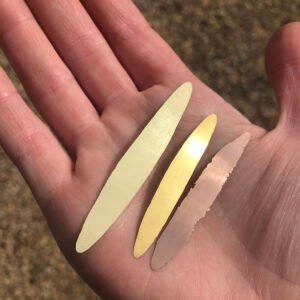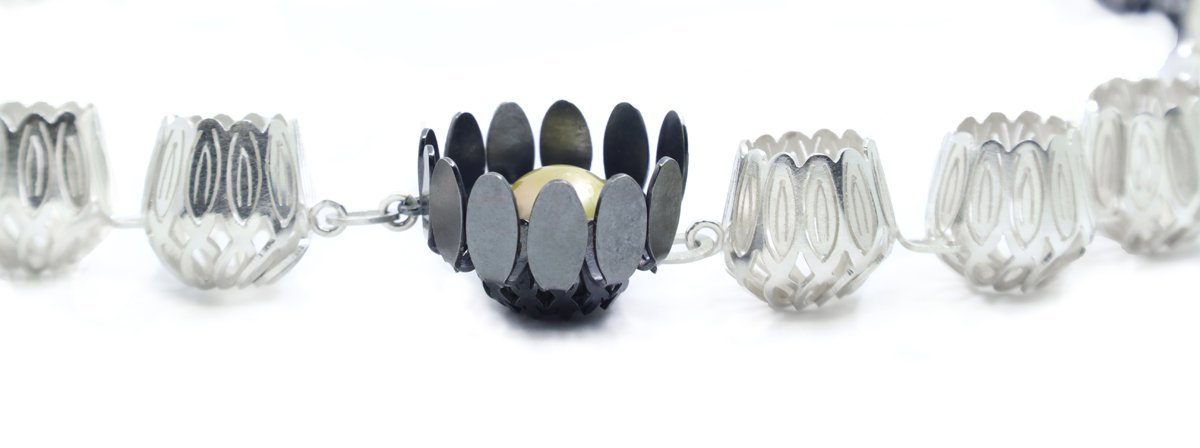Jeweler and silversmith Sorrel Acacia shares with us her experience during her residency at Bishopsland Educational Trust.
Sorrel is the winner of the Emerging Artist category in The Earring Show 2020 and is the first recipient of the Micki MacKenzie Craft Educational Bursary, also awarded in 2020.

Sorrel Acacia is a jeweler and silversmith with a background in welding and artistic blacksmithing. She graduated with a B.F.A., Major in Jewelry Design and Metalsmithing from the Nova Scotia College of Art and Design in 2020. Sorrel is the 2020 recipient of the Micki MacKenzie Craft Educational Bursary and is currently participating in a year-long silversmithing residency at Bishopsland Educational Trust, Berkshire, UK.
Hello! My name is Sorrel Acacia, and I will be creating short blog posts about my experience and training during my time at Bishopsland Educational Trust. I hope you enjoy following along on my adventure into the UK silversmithing and jewellery scene!
 Bishopsland is a unique residential program developed to bridge the gap between university and a career as a full-time silversmith or jeweller. Each year, nine emerging silversmiths and jewellers are selected to live and work in the countryside, staying onsite in small outbuildings and sharing a large stable that has been converted into a silversmithing studio. There is ample time spent designing and making, along with short, intensive masterclasses in enameling, raising, chasing and repousse, box making, and alloying. My year-long residency here is funded in part by the 2020 Micki MacKenzie Educational Craft Award, and I am incredibly grateful to the MacKenzie family and the Craft Council of British Columbia for their support. I feel extremely fortunate to have a studio to work in this year and to participate in this immersive experience alongside a group of my peers.
Bishopsland is a unique residential program developed to bridge the gap between university and a career as a full-time silversmith or jeweller. Each year, nine emerging silversmiths and jewellers are selected to live and work in the countryside, staying onsite in small outbuildings and sharing a large stable that has been converted into a silversmithing studio. There is ample time spent designing and making, along with short, intensive masterclasses in enameling, raising, chasing and repousse, box making, and alloying. My year-long residency here is funded in part by the 2020 Micki MacKenzie Educational Craft Award, and I am incredibly grateful to the MacKenzie family and the Craft Council of British Columbia for their support. I feel extremely fortunate to have a studio to work in this year and to participate in this immersive experience alongside a group of my peers.

This week at Bishopsland we enjoyed an engraving masterclass with Miriam Hanid. Miriam is a past resident of Bishopsland and a renowned silversmith who specializes in engraving, chasing and repousse. She began by demonstrating how to engrave a variety of lines with hand gravers and chiseling techniques. Miriam described the practice of engraving like ice skating; you skate along the metal, stop, and then flick the metal away. As a beginner I tended to dig the graver in too much, becoming stuck, or not enough and skidding over the surface, but after a few days I began to gain control over my graver and successfully created a small botanical design in silver. Miriam was a knowledgeable and patient teacher, and it was lovely to share in her passion for making tools and creating engraved textures in silver. I can’t wait to incorporate this new skill into my designs and can see the bright cuts and subtle highlights as a beautiful accent to my chasing and repousse work.
In the next blog entry I will be discussing our alloying masterclass, so check back for some metal math and the perfect golden Karat, just in time for easter ;).
 Over the past two weeks we have learned the ancient technique of precious metal alloying with British silversmith Patrick Davison. The fine silver and gold for this project was generously supplied by Cooksons Gold, a U.K.-based metal and tool supplier, with the option to purchase or return the alloys at the end of the masterclass.
Over the past two weeks we have learned the ancient technique of precious metal alloying with British silversmith Patrick Davison. The fine silver and gold for this project was generously supplied by Cooksons Gold, a U.K.-based metal and tool supplier, with the option to purchase or return the alloys at the end of the masterclass.
The first week we learned to use a ternary plot chart to calculate the percentages of copper, silver and gold required to create beautiful shades of green, rose, and yellow golds. Choosing our desired colours from the chart, we explored the subtle colour changes brought on by using more or less of each metal. Sharing our findings, it was fascinating to see the spectrum of golds created from only three elements.


I enjoyed creating a variety of alloys, including Shibuichi, a copper and silver alloy, and Shakudō, a gold and copper alloy, as well as several shades of green, rose and yellow golds. At first, I was taken with the idea of making green gold for my final project, as I had never worked with this particular alloy before. Green gold is created from fine gold and silver with little to no copper content which gives it a greenish tinge. However, after mixing up a lemon-yellow gold, I fell in love, and knew I wanted to keep working with this bright, malleable metal. Below is one of the anticlastic forms I created using my 22 karat yellow gold (92% gold, 4% silver, and 4% copper for those that want my secret recipe).

Having the opportunity to develop and work with a variety of golds was a very special experience for me. Primarily working with silver, I was captivated by how malleable and responsive gold is, especially while working with exceptionally thin sheets or wire. I also found it especially helpful to try different surface finishes on each alloy, satin matts, hammer texture, and high polish or gently heating and bathing the metal in acid to enrich the surface with fine gold, each finish bringing a different feeling to the metal.
The second week we had a chance to work with our chosen alloys by creating a jewellery piece or sampling techniques such as chasing and repousse or filigree. For my final piece I created a ring with twisted gold wire bands. Here are a few process images of my ring being formed and the application of hand twisted gold wire.

